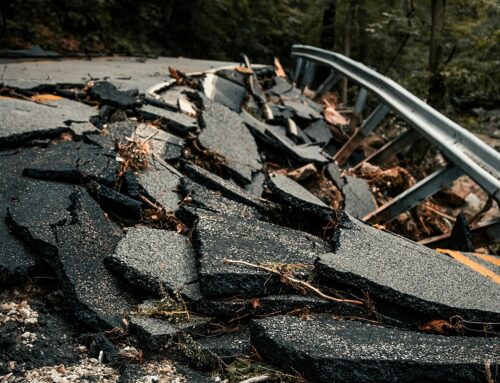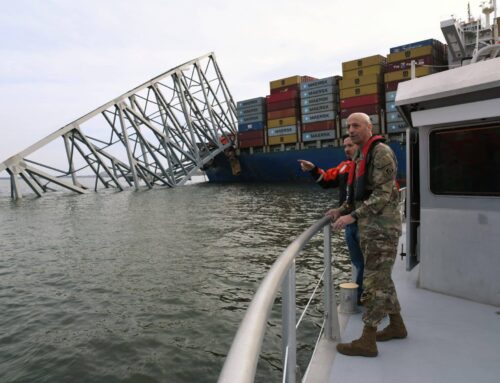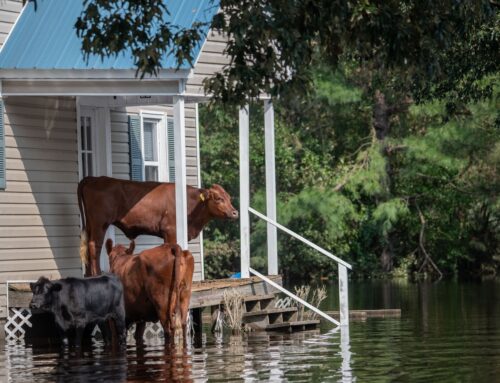Watch the hearing here or read TCS Vice President Steve Ellis' testimony below.
Testimony of Steve Ellis
Vice President, Taxpayers for Common Sense
Subcommittee on Housing and Insurance
Committee on Financial Services
Hearing
“Opportunities and Challenges Facing the National Flood Insurance Program”
January 12, 2015
Good morning, Chairman Luetkemeyer, Ranking Member Cleaver, members of the subcommittee. I am Steve Ellis, Vice President of Taxpayers for Common Sense, a national non-partisan budget watchdog. Thank you for inviting me to testify on opportunities and challenges facing the National Flood Insurance Program (NFIP). Given the ongoing flooding in the Mississippi River valley this hearing is tragically timely. My sympathies are with those affected by the floods. TCS has worked on flood insurance issues and reform of the program for our entire twenty year existence and I’ve been involved in flood issues dating back to my days as a young Coast Guard officer dealing with the aftermath of the Great Midwest Flood of 1993. This is a critical issue for taxpayers and we need better public policy that protects people and property.
Taxpayers for Common Sense is allied with SmarterSafer, a coalition in favor of promoting public safety through fiscally sound, environmentally responsible approaches to natural catastrophe policy. The groups involved represent a broad set of interests, from free market and taxpayer groups to consumer and housing advocates to environmental and insurance industry groups.[1] All the groups agree that NFIP should be made more responsible and greater reforms are needed.
Background on the National Flood Insurance Program
It is important to understand the context of how the nation got into the flood insurance business. After years of ad hoc disaster aid being meted out by Congress, the National Flood Insurance Program (NFIP) was established in 1968 to create “a reasonable method of sharing the risk of flood losses through a program of flood insurance which can complement and encourage preventative and protective measures.”[2] The program was to make up for a lack of available flood insurance. But even at that time Congress was warned that it was playing with fire. The Presidential Task Force on Federal Flood Control Policy wrote in 1966:
A flood insurance program is a tool that should be used expertly or not at all. Correctly applied it could promote wise use of flood plains. Incorrectly applied, it could exacerbate the whole problem of flood losses. For the Federal Government to subsidize low premium disaster insurance or provide insurance in which premiums are not proportionate to risk would be to invite economic waste of great magnitude.[3]
Well, we know which way that story unfolded. Although subsidies were largely envisioned to be limited and short-term, they weren’t. And while the program has encouraged standards and construction that help reduce flood risks for participating communities, the availability of subsidized federal flood insurance over the last several decades made it financially attractive to develop in high risk areas. Along with other factors, NFIP helped fuel the coastal development boom that increased the program’s risk exposure and losses.
$23 Billion in Debt and Subsidized Rates
For years NFIP teetered on either side of solvency, covering shortfalls with Treasury borrowing and repaying the loans in years of surplus. Then in 2005, the inevitable happened – a catastrophic loss year – and the program was roughly $18 billion in debt to the Treasury. That was followed by the Superstorm Sandy losses in 2012 and now the program is more than $23 billion in debt to taxpayers. To put that in perspective, FEMA data indicates that in 2014 the 5.4 million policies resulted in $3.6 billion in premium revenue to insure $1.3 trillion worth of property.[4] The Government Accountability Office has estimated that approximately 20 percent of policies are explicitly subsidized and paying only 35-45 percent of their actual full-risk level premiums.[5] These numbers have likely changed some subsequent to the enactment of the Homeowners Flood Insurance Affordability Act of 2014 also known as Grimm-Waters.
As this Subcommittee well knows, reforms to the NFIP were enacted in the Biggert-Waters Flood Insurance Reform Act of 2012 to increase premiums to more risk-based rates, which would not only help program solvency, but also help policyholders better understand their risk and take measures to mitigate that risk. Despite some concerns, TCS supported the 2012 legislation while also favoring additional efforts to help address affordability issues. Unfortunately, in Grimm-Waters, Congress rolled back many of the Biggert-Waters reforms that would have led to more actuarial rates.
The authorization for NFIP expires September 30, 2017. Before the long-term reauthorization in 2012, NFIP required 17 extensions after the 2004 reauthorization expired in 2009 and even occasionally lapsed only to be retroactively reauthorized. So while expiration is a year and half and another Congress away, now is the time to review possible changes and improvements to the program and what better way to start than to look at the challenges and opportunities facing the program.
Challenges
Debt – As I previously indicated, NFIP is $23 billion in debt plus interest. After a relatively light claim year in 2013, that total is $1 billion less than the $24 billion debt after Superstorm Sandy. Even without paying another claim, it would take decades to repay the debt the program owes to taxpayers. Clearly this is a challenge, but I would also argue that the debt is a clear reminder of some of the problems with the program and helps garner public and policymaker attention. In addition, after Superstorm Sandy the program’s borrowing limit was set at a little more than $30 billion. Another storm of similar impact will push the program to the borrowing limit.
Adverse selection – The simple fact is that most of the people who are purchasing flood insurance are those most likely to get a payout. As I indicated there are 5.4 million policyholders in the program. According to the U.S. Census Bureau there are 134 million housing units[6] in the country and even leaving out multi-unit structures – that could be purchasing flood insurance – and commercial properties, roughly 5.4 percent of the houses in the country have flood insurance. Just about everybody has some level of flood risk, but for the most part unless it’s acute they don’t buy it. That puts strain on the program, particularly if you can’t charge risk-based rates. The private sector would have other options, they could write multi-peril insurance that includes flood and is more attractive, and they can also lay off risk on the worldwide reinsurance marketplace.
Subsidies – Subsidies have been present in the program virtually from the beginning. Even with the supposed risk-based premiums, the fact that the program can borrow from the Treasury is a subsidy. As I mentioned earlier, the GAO has documented large cross-subsidies, many of which benefit high-income homeowners.[7] This represents a real challenge for the program’s sustainability. While we are committed to rolling back premium subsidies, we realize that there needs to be a mechanism to provide means-tested, time-limited assistance outside the rate structure to lower income ratepayers. It is important that any assistance be outside the rate structure to not mask risk. Policyholders have a right to know their level of risk and price is an indicator of that. But in reality the best way to address price is to lower the rate by reducing the risk.
Maps – FEMA has to map the Special Flood Hazard Area. This delineates the area with a mandatory purchase requirement for federally backed mortgages. These maps are the backbone of the NFIP and are used to determine rates. The maps have to be accurate. The current lack of confidence in the flood maps hobbles FEMA implementation of the program. I will discuss more on mapping later in the testimony.
Opportunities
Private sector alternatives – The only reason a policyholder will opt for private insurance over NFIP is that the private insurance offers a better product, a better price, or both. To stifle the private market would be akin to the federal government forcing policyholders to pay more. There is already interest in the private sector to write flood. It is true that NFIP was created because there wasn’t a functioning private insurance marketplace, but that was nearly fifty years ago. It almost goes without saying that technology and modeling have advanced dramatically. Imagery and mapping technology has similarly developed. The reinsurance and financial instruments to manage risk are much larger and more diversified. I know the Committee will be having a hearing tomorrow on H.R. 2901, the Flood Insurance Market Parity and Modernization Act. We support this common sense measure to allow state insurance commissioners to certify that appropriate flood insurance products meet the mandatory purchase requirements.
Reinsurance – In the submission of the reinsurance study mandated by Biggert-Waters, FEMA stated that it has “determined that reinsuring a portion of the NFIP’s insurance risk would be a logical step toward privatization and could provide an additional lever in the financial management of the NFIP.”[8] We agree. There is interest and capacity in the reinsurance markets to take on U.S. flood risk. Obviously industry will have to gain a greater understanding of the nature of the underlying flood risk in the NFIP portfolio, but that can be managed through responsible data sharing. Laying off risk on the private sector will help protect taxpayers from debts racked up by future large storms.
Mitigation – Subsidized rates provide a disincentive to mitigation, but as rates gradually increase there is more incentive for individuals, and by extension communities, to mitigate. These should be encouraged by further federal investment. We know that each dollar of mitigation reduces post-disaster costs by four dollars or more.[9] Instead of providing premium subsidies the goal should be to reduce rates by reducing risk. Conversely, subsidizing rates does not reduce risk to people and property, in fact it encourages people to develop or stay in high risk areas.
Mapping – Mapping is both a challenge and an opportunity. Technology has enabled greater level of detail and accuracy in mapping. It also can be used by the private sector for more intensive risk analysis and modeling that can benefit private sector flood insurance alternatives (and NFIP as well) particularly in providing risk-based coverage in areas outside the SFHA.
Disaster Assistance – NFIP’s inter-relationship with federal disaster aid programs under the Stafford Act is both an opportunity for reform and a challenge to a more rational holistic federal approach.
An observation from the FEMA privatization report early last year “… highly publicized instances of federal aid following catastrophic events have also created a public perception that individual property owners do not need to insure against low-probability high severity flood events, effectively creating moral hazard.”[10] What people are not realizing is that the vast majority of the aid goes to rebuild public and federal infrastructure, not individuals to help them move on after disaster. A 2014 study by the Wharton Center for Risk Management and Decision Processes at the University of Pennsylvania found that increasing disaster assistance by $1,000 reduced subsequent insurance coverage by $6,000.[11] The average direct individual aid can be measured in the few thousand dollars, and absent flood insurance the homeowner is left with low interest Small Business Administration loans to rebuild. Piling a loan on top of a mortgage to rebuild a currently uninhabitable house is not conducive to efficient and resilient rebuilding.
Additional Points
In addition, the Committee asked me to address several specific points:
- Is the NFIP the ideal model for effective protection of residential and commercial property owners?
No. NFIP was created nearly 50 years ago because of market failure. That same year, 1968, federal riot insurance was created. That ceased in the 1980s when it was clear the marketplace would bear that risk.[12] It is clear that the insurance industry is hungry for this risk and can provide it. To be clear, I’m not suggesting eliminating NFIP tomorrow or anything close to that. There are community mitigation benefits from the Community Rating System and there are properties that would see significantly larger premiums in the private marketplace. But a primarily private sector program is where flood insurance is heading and should head. This is already happening and in the coming decades NFIP will likely become a residual market for policyholders that cannot obtain private insurance. This will be a limited set of policies and is not unlike residual homeowners insurance programs at the state level. But Congress should be intentional about this development and ensure the mitigation benefits achieved by NFIP are retained and funds for mapping maintained.
- FEMA’s efforts to accurately predict flood risks, price for flood risks, and create an efficient administrative mechanism to serve policyholders.
I know that FEMA is working hard to update the maps, and has the new Technical Mapping Advisory Council to help guide them in their work. I also know that the mapping efforts have not received full funding the last several years which inhibits their progress. All that said, more needs to be done for the public to have a greater understanding of their flood risk. As discussed earlier, FEMA is tasked with mapping the Special Flood Hazard Area for the mandatory purchase requirement. That is a federal mandate that isn’t likely to change. However these maps are static – lines on a map designating various flood risk areas and charging various rates based on those risks. If a homeowner has an elevation certificate that proves they are elevated “out” of the floodplain they can have those rates adjusted. But the creation of the rates is sort of a black box and it is not entirely clear that even “full-risk” rates are actuarially sound.[13] In some cases there are significant cross-subsidies where lower risk properties pay more to maintain subsidies for higher risk properties.
- Reforms that could improve the program’s efficiency and reduce fraud, abuse and waste.
As with any federal program, it is critical that taxpayers and participants in the program believe that it is operated fairly and that waste, fraud, and abuse will not be tolerated. I believe that as the private sector has greater involvement in the flood insurance marketplace it will be harder to abuse this system. This is not to suggest that there aren’t scams and abusive practices in private sector insurance, but as envisioned by H.R. 2901 addressed above, it will be regulated at the state level by the insurance commissioner that has experience – more than FEMA – at dealing with these issues and the particular companies.
In addition, there has to be greater communication between flood claims and mapping. While it is true that just because a property has never flooded in no way guarantees it won’t flood, the converse does provide an indicator. Absent significant mitigation action for structural changes, a property that has flooded is certainly at risk of flooding again. Yet, in a three-part series published in early 2014, NBC News documented instances where FEMA agreed to remap large condominiums built in previously flooded areas out of the floodplain.[14] One company head that made the remapping program his business (only for commercial properties not residential) dubbed himself “Robin Hood.” Hardly. Maps have to be accurate for both sides. Taxpayers and ratepayers.
Also, there can be gamesmanship in determining whether a property is more than 50 percent damaged, triggering requirements to elevate or otherwise mitigate.
- How the NFIP and private sector could better serve high-impacted communities and modernize mapping systems while incorporating local community mitigation efforts.
There’s no way around it. The maps have to be accurate. And smarter. There is a whole industry that has very accurate data. FEMA should explore data sharing and further contracting with them. There are also many different federal agencies that engage in mapping. This should be better coordinated and shared among agencies to avoid duplication. This is also where – and I know this is also outside the committee’s jurisdiction – the nation’s mitigation and pre-disaster programs have to dovetail with NFIP and post-disaster response.
- The issue of affordability for families living in high-impacted communities with few personal or community resources to pay actuarial flood rates.
The affordability issue has to be addressed. But it must be done in a means-tested, targeted, and time-limited manner. Currently subsidies are effectively hidden from the homeowner, which eliminates any price signal of risk or incentive to mitigate to reduce the risk and thereby the premium. Masking subsidies with lower rates prevents policyholders from understanding their true level of risk. As was noted in the privatization report mandated by Biggert-Waters, subsidized rates “can promote (and have promoted) poor decisions on the part of property owners and political representatives … they also create a moral hazard, especially when the subsidies are not well targeted.”[15]
The report continues that the presence of subsidies “removes the incentive to undertake mitigation efforts, thereby encouraging ever increasing societal costs.” A far better approach is to encourage and fund mitigation measures that could serve to reduce rates by reducing risk.
Conclusion
Private insurers are ready to write flood insurance and as NFIP rates rise in the program to be more in line with risk this will become even more so. With more insurers writing flood insurance there should be a growth in overall coverage in the U.S. while the federal program develops into a residual market. This will take a decade or more, but Congress should work with the Administration to manage the transition and use targeted mitigation tactics that make these remaining policies more commercially insurable. There is no need for the federal government to further extend into the catastrophe insurance market through reinsurance or other means.
[1] Full list of groups is available at www.smartersafer.org
[2] P.L. 90-448.
[3] U.S. Task Force on Federal Flood Control Policy. “A Unified National Program for Managing Flood Losses.” August 1966. P 17. http://www.loc.gov/law/find/hearings/floods/floods89-465.pdf
[4] Federal Emergency Management Agency. Available at: https://www.fema.gov/statistics-calendar-year
[5] Government Accountability Office. “Flood Insurance: More Information Needed on Subsidized Policies.” July 2013.
[7] Supra note 5.
[8] FEMA. “Report to Congress on Reinsuring NFIP Insurance Risk and Options for Privatizing the NFIP.” P6. Available at: http://www.floods.org/ace-files/documentlibrary/2012_NFIP_Reform/Reinsuring_NFIP_Insurance_Risk_and_Options_for_Privatizing_the_NFIP_Report.pdf
[9] Multi-Hazard Mitigation Council. Natural Hazard Mitigation Saves: An Independent Study to Assess the Future Savings from Mitigation Activities. Available at: https://c.ymcdn.com/sites/www.nibs.org/resource/resmgr/MMC/hms_vol1.pdf
[10] Oliver Wyman. Flood Insurance Risk Study: “Options for Privatizing the NFIP. P52 Available at: http://www.floods.org/ace-files/documentlibrary/2012_NFIP_Reform/Reinsuring_NFIP_Insurance_Risk_and_Options_for_Privatizing_the_NFIP_Report.pdf
[11] Kousky, Michel-Kerjan, Raschky. Does Federal Disaster Assistance Crowd Out Private Demand for Insurance? Available at: http://opim.wharton.upenn.edu/risk/library/WP2013-10_FedDisasterAssistance.pdf
[12] Webel. “Terrorism Risk Insurance: Issue Analysis and Overview of Current Program,” Congressional Research Service. April 26, 2013. P. 7.
[13] Beider. “Understanding FEMA’s Rate-Setting Methods for the National Flood Insurance Program.” Congressional Budget Office. October 7, 2014. Available at: https://www.cbo.gov/sites/default/files/presentation/49441-femaratemethodsnfip.pdf
[14] Dedman. “Why Taxpayers Will Bail Out the Rich When the Next Storm Hits US” http://www.nbcnews.com/news/investigations/why-taxpayers-will-bail-out-rich-when-next-storm-hits-n25901 NBC News.
[15] Oliver Wyman. Flood Insurance Risk Study: “Options for Privatizing the NFIP. P60 Available at: http://www.floods.org/ace-files/documentlibrary/2012_NFIP_Reform/Reinsuring_NFIP_Insurance_Risk_and_Options_for_Privatizing_the_NFIP_Report.pdf














Get Social